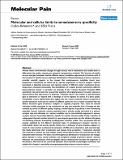Por favor, use este identificador para citar o enlazar a este item:
http://hdl.handle.net/10261/3774COMPARTIR / EXPORTAR:
 SHARE SHARE
 CORE
BASE CORE
BASE
|
|
| Visualizar otros formatos: MARC | Dublin Core | RDF | ORE | MODS | METS | DIDL | DATACITE | |

| Título: | Molecular and cellular limits to somatosensory specificity |
Autor: | Belmonte, Carlos CSIC ORCID; Viana, Félix CSIC ORCID | Fecha de publicación: | 2008 | Editor: | BioMed Central | Citación: | Molecular Pain 2008, 4:14 | Resumen: | Animals detect environmental changes through sensory neural mechanisms that enable them to differentiate the quality, intensity and temporal characteristics of stimuli. The 'doctrine of specific nervous energies' postulates that the different sensory modalities experienced by humans result of the activation of specific nervous pathways. Identification of functional classes of sensory receptors provided scientific support to the concept that somatosensory modalities (touch, pain, temperature, kinesthesis) are subserved by separate populations of sensory receptor neurons specialized in detecting innocuous and injurious stimuli of different quality (mechanical forces, temperature, chemical compounds). The identification of receptor proteins activated by different physicochemical stimuli, in particular ion channels of the Transient Receptor Potential (TRP) superfamily, has put forward the concept that specificity of peripheral sensory receptor neurons is determined by their expression of a particular "molecular sensor" that confers to each functional type its selectivity to respond with a discharge of nerve impulses to stimuli of a given quality. Nonetheless, recent experimental data suggest that the various molecular sensors proposed as specific transducer molecules for stimuli of different quality are not as neatly associated with the distinct functional types of sensory receptors as originally proposed. First, many ion channel molecules initially associated to the transduction of only one particular form of energy are also activated by stimuli of different quality, implying a limited degree of specificity in their transducing capacities. Second, molecular sensors associated with a stimulus quality and hence to a sensory receptor type and ultimately to a sensory modality may be concomitantly expressed in sensory receptor neurons functionally defined as specific for another stimulus quality. Finally, activation of voltage gated channels involved primarily in nerve impulse generation can also influence the gating of transducing channels, dramatically modifying their activation profile. Thus, we propose that the capacity exhibited by the different functional types of somatosensory receptor neurons to preferentially detect and encode specific stimuli into a discharge of nerve impulses, appears to result of a characteristic combinatorial expression of different ion channels in each neuronal type that finally determines their transduction and impulse firing properties. Transduction channels don't operate in isolation and their cellular context should also be taken into consideration to fully understand their function. Moreover, the inhomogeneous distribution of transduction and voltage-gated channels at soma, axonal branches and peripheral endings of primary sensory neurons influences the characteristics of the propagated impulse discharge that encodes the properties of the stimulus. Alteration of this concerted operation of ion channels in pathological conditions may underlie the changes in excitability accompanying peripheral sensory neuron injuries. | URI: | http://hdl.handle.net/10261/3774 | DOI: | 10.1186/1744-8069-4-14 | ISSN: | 1744-8069 |
| Aparece en las colecciones: | (IN) Artículos |
Ficheros en este ítem:
| Fichero | Descripción | Tamaño | Formato | |
|---|---|---|---|---|
| cellular.pdf | 974,7 kB | Adobe PDF |  Visualizar/Abrir |
CORE Recommender
PubMed Central
Citations
46
checked on 20-abr-2024
SCOPUSTM
Citations
112
checked on 16-abr-2024
WEB OF SCIENCETM
Citations
97
checked on 27-feb-2024
Page view(s)
419
checked on 23-abr-2024
Download(s)
262
checked on 23-abr-2024
Google ScholarTM
Check
Altmetric
Altmetric
Artículos relacionados:
NOTA: Los ítems de Digital.CSIC están protegidos por copyright, con todos los derechos reservados, a menos que se indique lo contrario.
